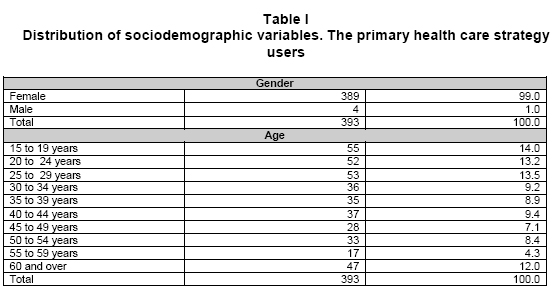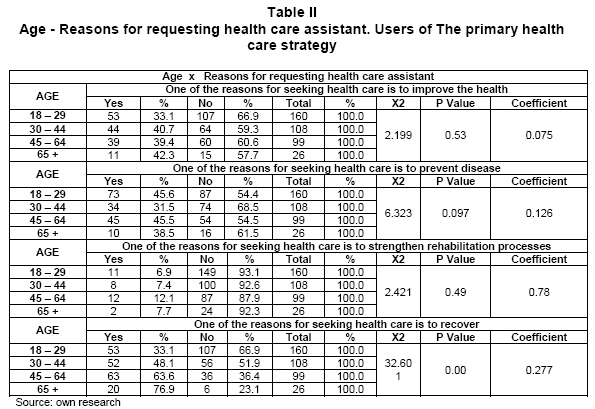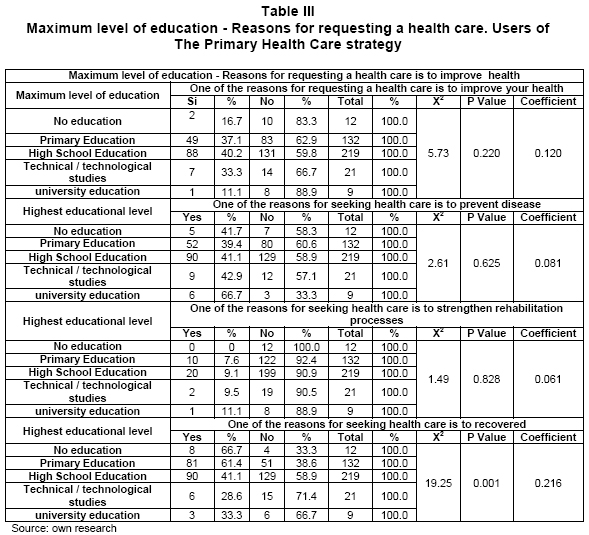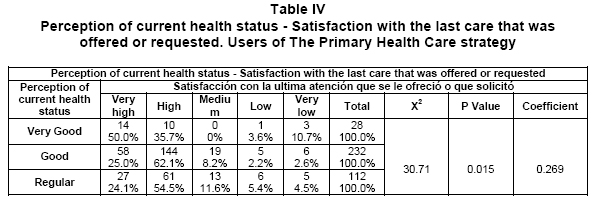My SciELO
Services on Demand
Journal
Article
Indicators
-
 Cited by SciELO
Cited by SciELO -
 Access statistics
Access statistics
Related links
-
 Cited by Google
Cited by Google -
 Similars in
SciELO
Similars in
SciELO -
 Similars in Google
Similars in Google
Share
Enfermería Global
On-line version ISSN 1695-6141
Enferm. glob. vol.13 n.34 Murcia Apr. 2014
ADMINISTRACIÓN-GESTIÓN-CALIDAD
The primary health care from the users perspective
La atención primaria de salud desde la perspectiva de los usuarios
Giraldo Osorio, Alexandra* and Vélez Álvarez, Consuelo**
*Health Promotion and Disease Prevention Research group, Program for Young Researchers and Innovators. E-mail: alegiros@hotmail.com
**Public Health Department, Health Promotion and Disease Prevention Research group. University of Caldas. Colombia
This article is the result of the Research Project " The current status of the strategy of Primary Health Care in Manizales" developed under the grant for Young Researchers and Innovators of Colciencias (Convening 525), Colombia. April 2012 - April 2013.
ABSTRACT
Objective: To identify the characteristics of the development of the Primary Health Care strategy according to the users and factors that relate to the use of services.
Materials and methods: Descriptive and mixed study. This study included 393 primary health care users. The sample selection was made according to established criteria. It used the focus group and the survey. The information was categorized and processed in SPSS 15.0.
Results: The average age was 37.62 years. The main reasons for seeking care are recovering and disease prevent. The age was associated significantly with recover as one of the reasons for seeking attention p<0.05. The highest level of studies showed statistically significant association with recovery as a reason for requesting attention p <0.05 and the health status perception was associated with satisfaction with care last was offered or requested p<0.05.
Conclusions: The activities were directed to priority groups. The users benefited from the services through family visit, health day, mobile unit and community meetings. The factors related to services use were age, gender, geographic accessibility, satisfaction with the last care received, health status perception and recovery as one of the reasons for seeking health care.
Keywords: Primary health care; patient satisfaction; quality of health care; delivery of health care; health services; patient care.
RESUMEN
Objetivos: Identificar las características del desarrollo de la estrategia de Atención Primaria de Salud desde la perspectiva de los usuarios y los factores que se relacionan con la utilización de los servicios.
Materiales y métodos: Estudio descriptivo, mixto. Muestra 393 usuarios beneficiarios de la estrategia. La selección de la muestra se realizó según criterios establecidos. Se utilizaron el grupo focal y la encuesta. La información fue categorizada y procesada en el SPSS 15.0.
Resultados: La edad promedio fue 37.62 años. Las principales razones para solicitar una atención fueron recuperarse y prevenir la enfermedad. La edad se asoció significativamente con recuperarse como una razón para solicitar una atención p<0.05, el máximo nivel de estudios presentó asociación estadísticamente significativa con recuperarse como una razón para solicitar una atención p<0.05 y la percepción del estado de salud se asoció con la satisfacción con la ultima atención que se le ofreció o solicitó p<0.05.
Conclusiones: Las actividades estaban dirigidas a grupos prioritarios. Los medios por los cuales los usuarios se beneficiaron del servicio fueron visita familiar, jornada de salud, unidad móvil y reuniones comunitarias. Los factores que se relacionaron con la utilización de los servicios fueron edad, género, accesibilidad geográfica, satisfacción con la última atención recibida, percepción del estado de salud y recuperarse como una razón para solicitar una atención.
Palabras clave: Atención primaria de salud; satisfacción del paciente; calidad de la atención de salud; prestación de atención de salud; servicios de salud; atención al paciente.
Introduction
The primary health care (PHC) (APS for its initials in Spanish) is a strategy that has proven cost-effective results about the condition and quality of life of the population. The evaluation of health services is a type of research that provides scientifically valid information to those who must make substantiated decisions and have valid knowledge of the health policy planning(1); which constitutes a key element for the continuous improvement of the quality of care(2).
Some authors have emphasized considering the users profiles in order to guide the institutional change efforts(3) and the need for assessments that integrate aspects of the diversity of functions performed within the framework of the strategy of primary health care. Studies agree that through the evaluation aimed at users, they give more importance to issues such as the availability of time and services, accessibility, continuity of care, information they receive about their health problems, and the doctor-patient relationship, while putting less emphasis on the administrative aspects(3,4).
The evaluation of the primary health care strategy from a user's perspective is essential in all areas of the health system(5). Several studies have evaluated the satisfaction of users of health as a measure of quality of care, satisfaction is seen as a positive evaluation of the patient on the care received. This encourages the adherence of these service providers and directs improvements in health organizations(2,3,6,7).
Service evaluation is an exercise that promotes reflection and oriented analyses that leads to improvements in health care for the population; this purpose is useful and relevant to assessments at local, national and international level(8-10).
The objective of this work is to identify the characteristics of the development of the primary health care strategy, assessed from the perspective of users and factors that relate to the use of services by them.
Methods and materials
A mixed approach that values the characteristics of primary health care from the users perspective. Group discussion and surveys were used as techniques, and as tools, discussion guides and questionnaires and semi-structured questions were used. The study population consisted of 72.804 people beneficiaries of the strategy The sample size was calculated with a reliability level of 95%, a margin of error of 5% and a value of p=0,5 (proportion of people who are beneficiaries of The primary health strategy). The final sample was 393 people. 5 focus groups composed of minimum five and maximum seven people were performed, with participation of both genders, attendees of the health center groups, different from the people surveyed.
Inclusion criteria for the selection of the sample were residents of the geographic area for the development of the strategy, who have been the beneficiary of health care and must be 18 or older. For data collection a pilot test was conducted in health centers corresponding to the geographic areas prioritized for development of the strategy and then all of the information was collected; in a manner directed upon request of informed consent. For the analysis the qualitative information is categorized and retaking the characteristics of primary health care. The quantitative data were processed and analyzed in the program SPSS 15.0. A descriptive analysis was performed (frequency distribution tables, measures of central tendency and dispersion), and bivariate analysis (chi2 test and contingency coefficient, according to the nature of the variable).
Based on Resolution 08430 of 1993 and the Declaration of Helsinki in 2000, research conducted is part of the projects without risk. It had the consent of participants(12,13).
Outcomes
393 users who had been treated in the framework of the the primary health care strategy were included in different health centers; 389 female and 4 male. The minimum age was 18 years with a maximum of 93 years, the average was 37.62 years + / -15.7 years. 51.4% had their residence in the socioeconomic status 1. 52.2% belonged to a type of large families (Table I).
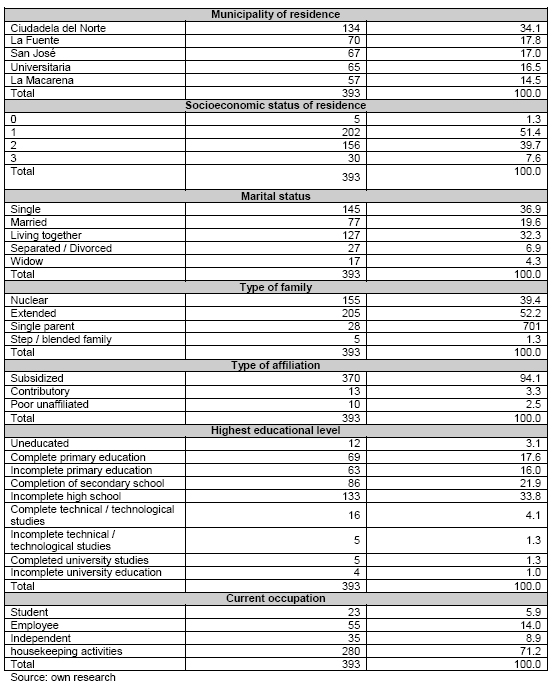
It was found that the activities were carried out mainly in priority groups such as children under 10 years of age, adolescents, pregnant women and adults over 65. It is emphasized that the services that have been offered at higher rates are: education for adolescents (n=265) and adults (n=251), vaccination for women of childbearing age (n=247), youth advice services / care to adolescents (n=213), education for children under 10 years (n=202), oral health care and oral hygiene education in adolescents (n=173), growth and development program (n=146), vaccination for children under 6 years (n=144), oral health care and oral hygiene education in adults (n=143) and counseling and family planning consultations (n=137). Services that have requested a higher proportion of care have been related to the most common diseases in children (n=201), smear tests, breast exam and adult testicular tests (n=154). In contrast to this, the services have been offered or that users have requested to a lesser degree are mental health care in children under 10 years and adults caring for people with disabilities and children under 10 years, adolescents and adults; identifying cases of abuse in children under 10 years, in adolescents and adults, and care epidemics in children under 10 years, in adolescents and adults. The means by which users have benefited from health care, has been family visits (100%), health day (34.1%) mobile unit (27.5%) and community meetings (1.4%). 92.4% reported that the time in which the family visits were performed ,was appropriate for their personal and family needs. In the focus groups it was found that the care team frequently performed monitoring of the health status of users through family visits and phone calls, whereupon participants stated that "usually they get a call to find out if they are taking the drug or they are reminded if and when there is a pending appointment ... also when the test results come out wrong, they get a call where they get an explaination of what to do next." The reasons why users request health care attention are mainly for the purpose of recovering from any ilness and to prevent disease (47.8% and 41.2% respectively).
In Table II it should be noted that between age and recovery time one of the reasons for seeking health care a statistically significant association exists (Chi2=32,6/ p=0,00/ Contingency coefficient =0,27). The same way at applying statistical tests, association and dependency between the maximum level of recovery studies were found to be one of the reasons for seeking health care (Chi2=19,25/ p=0,001/ Contingency coefficient =0,21) (Tabla III). No association and dependence between the type of family and the reasons for seeking health care was found.
87.5% of users reported that their perceived health status was between good and regular. Association and moderate dependence was found between the perception of current health status and satisfaction with the last care offered or requested (Chi2=30,71/ p=0,015/ Contingency coefficient =0,269) (Table IV). Users rated as a high or very high (83.7% satisfaction level with the latest health care offered or requested.

As for the time that users take to travel from their place of residence to the nearest health center, 44.2% said it is from 0 to 10 minutes, followed by 38.7%. that said it takes them 11 to 20 minutes.
In the focus groups the work done by health promoters was identified as a strength. Weaknesses were the lack of drug delivery in a timely manner and timeliness (in some cases) to the attention of scheduled appointments: "... Sometimes they do not give you the drugs from the health center that it is closest to you...". "... One often arrives 20 minutes before the appointment is scheduled, but the doctors see you 30 minutes later. However, it is very unfair that if you are five minutes late, you will miss the appointment". It was highlighted that the lack of continuity in health care was due to the barriers by the Health Promoting Entities (EPS initials in Spanish) it was stressed: "... No matter if they give us the referral here, if the Health Promoting Entities do not authorize it ..." "... referrals often expire then you have to start all over again by asking for a new general practitioner appointment ... ".
Discussion
Faced with the sociodemographic characteristics of users of the primary health care strategy, gender and age influenced the use of services, since on one hand it can act as modulators of care(14) and on the other hand it may be considered inherent to health factors, particularly when it has not been fully controlled(15). Bellón Et al(16) y Mello Et al(17) found that women use primary health care services more than men, as can be seen in this study. Bellón Et al, found that those who use these services were mostly in the ages 35 to 75(16) years, in contrast to what was previously believed that the most users are between 18 and 29 years. Regarding the type of family the users of the strategy belong to, it has been found that the fact of belonging to a single parent family is associated with greater use of health services(18), different from the results obtained in this research which shows that most often the formation of families is extensive and of the nuclear type (52.2% y 39.4% respectively). Other scientific evidence shows that there are differences in accessibility to health services, especially in the waiting time in the office, depending on the socioeconomic status of individuals(2). In regards to geographical accessibility Acosta L, et al, reported that this was considered to be acceptable by the respondents, such as users who participated in this study(2). Research has indicated an important determinant for the use of primary health care services is the educational level of the parents, especially the mother(19) and have also been reported in terms of occupation, the fact that independent work is related to lower utilization of health services compared with other workers(20), in agreement with the results obtained in this study in which greater use of services is seen by persons engaged in household activities and work dependently (71.2% and 14% respectively). The evidence shows that the use of primary care services is primarily concerned with the health of the individual, whether it is self-perceived(17,21,22). This study found that 87.5% of users rated their health status between good and regular. Regarding the importance that users granted the health promoter for its work with the community, it was found in publications which are also assigned a higher level of qualification on other people who are part of the health team, since they are the ones who most often have contact with individuals, families and communities(23). Studies have reported that they have promoted a series of actions aimed at facilitating access to services among which it is worth noting the management of care offered by the EPS(24), similar to what the primary care team has conducted in order to provide continuity of health care to the users.
One study reported that 66.7% of patients were satisfied or very satisfied with the care received(25); similar to the level of satisfaction with the health care last reported in this work (83,7%). Given the lack of opportunity for the delivery of drugs, studies done(2,26) have noted this as one of the most critical aspect. In relation to the continuity of care -accessibility between levels, there is agreement in the literature that changes in level of care threatening the continuity of care(27,28); this was evident in the results obtained from users at higher levels of health care.
Conclusions
Among the main features of the primary health care strategy the biggest highlights are the services to which users have had access; most are aimed at children under 10 years of age, adolescents, pregnant women, and adults over 65. The means by which users who have had access to health care through the primary health care strategy have mostly been family visits, health days and the mobile unit.
The reasons that users have requested health care are mainly to recover and prevent disease. The users reported that they perceive their health status is between good and regular. The level of satisfaction with the health care service was between high and very high.
Factors relating to the utilization of services were age, gender, geographical accessibility, satisfaction with care received on the last visit, the perception of health status and the wishes to recover, as the reasons for seeking health care.
Acknowledgment
To the Colciencias Programme for Young Researchers and Innovators, To the Group of Health Research - Health Promoting and Disease Prevention at the University of Caldas, to the health facility in which the study was conducted and to the users for their participation in this study.
References
1. Villalbí JR, Pasarín M, Montaner I, Cabezas C, Starfield B, y Grupo de Trabajo sobre Evaluación en la Atención Primaria de Salud de Barcelona. Evaluación de la atención primaria de salud. Aten Primaria 2003;31:382-385. [ Links ]
2. Acosta L, Burrone MS, Lopez de Neira MJ, Lucchese M, Cometto C, Ciuffolini B, et al. Análisis de la satisfacción del usuario en centros de salud del primer nivel de atención en la provincia de Córdoba, Argentina. Enfermería Global 2011; 21:1-14. [ Links ]
3. Cuba-Fuentes M, Jurado A, Estrella E. Evaluación del cumplimiento de los atributos de la Atención Primaria y grado de satisfacción de los usuarios de un establecimiento de primer nivel de atención. Rev Med Hered 2011; 22(1):4-9. [ Links ]
4. Kerssens JJ, Groenewegen P, Sixma HJ, Boerma WG, Van der Eijk I. Comparison of patient evaluations of health care quality in relation to WHO measures of achievement in 12 European countries. Bull World Health Organ 2004;82:106-14. [ Links ]
5. Briggs C, Capdegelle P, Garner P. Strategies for integrating primary health services in middleand low-income countries: effects on performance, costs and patient outcomes. 1ra ed. The Cochrane Collaboration: Jhon Wiley & Sons, Ltda; 2006. [ Links ]
6. Pasarín Rua M, Berra S, Rajmil L, Solans M, Borrell C, Starfield B. Un instrumento para la evaluación de la atención primaria de salud desde la perspectiva de la población. Aten Primaria 2007;39(8):395-403. [ Links ]
7. Jiménez Villa J. La evaluación necesita la perspectiva de la población. Aten Primaria 2007; 39(8):395-403. [ Links ]
8. Feldman L, Vivas E, Lugli Z, Alviarez V, Pérez MG, S B. La satisfacción del paciente hospitalario: una propuesta de evaluación. Rev Calid Asist 2007; 22:133-173. [ Links ]
9. Mira JJ, Rodríguez-Marín J, Pesetb R, Ybarra J, Pérez-Jover V, Palazón I, et al. Causas de satisfacción y de insatisfacción de los pacientes en hospitales y atención primaria. Rev Calid Asist 2002; 17:273-283. [ Links ]
10. Redondo Martín S, Bolaños Gallardo E, Almaraz Gómez A, Maderuelo Fernández J. Perceptions and expectations of Primary health care: a new form of identifying improvements. Aten Primaria. 2005; 36:358-366. [ Links ]
11. ASSBASALUD, Secretaría de salud Municipal. Propuesta para el desarrollo de la estrategia Atencion Primaria en Salud en las comunas y corregimientos del Municipio de Manizales, en el marco de las Redes Integradas de Servicios de Salud. Manizales; 2012. [ Links ]
12. Resolución No. 008430 de 4 de octubre de 1993, por la cual se establecen las normas científicas, técnicas y administrativas para la investigación en salud. En: Bogotá D.C: Ministerio de Salud; 1993. [ Links ]
13. Asociación Médica Mundial. Declaración de Helsinki. Principios éticos para las investigaciones médicas en seres humanos. España: Universidad de Navarra; 2004. [ Links ]
14. Chang W. The meaning and goals of equity in health. J Epidemiol Community Health 2002; 56:488-579. [ Links ]
15. Sáez M. Condicionantes en la utilización de los servicios de atención primaria. Evidencias empíricas e inconsistencias metodológicas. Gac Sanit 2003; 17(5):412-417. [ Links ]
16. Bellón J, Delgado A, Luna J, Lardelli P. Influencia de la edad y sexo sobre los distintos tipos de utilización en atención primaria. Gac Sanit 1995;9:343-396. [ Links ]
17. Mello M, Stearns S, Norton E. Do Medicare HMOs still reduce health services use after controlling for selection bias?. Health Econ 2002;11:323-363. [ Links ]
18. Muñoz-Pérez M, Mariscal E, Rubio E, Rey I. Desigualdades sociales en la utilización de servicios de atención primaria: un largo camino por recorrer. Gac Sanit 2000; 14:233-239. [ Links ]
19. Halldórsson M, Kunst A, Köhler L, Mackenbach J. Socioeconomic differences in children's use of physician services in the Nordic countries. J Epidemiol Community Health 2002; 56:200-204. [ Links ]
20. Álvarez B. La demanda atendida de consultas médicas y servicios urgentes en España. Investigaciones Económicas 2001; 25:93-138. [ Links ]
21. Jiménez-Martín S, Labeaga J, Martínez-Granado M. Latent class versus two-part models in the demand for physician services across the European Union. Health Econ 2002; 11:301-322. [ Links ]
22. Vera-Hernández A. Duplicate coverage and demand for health care. The case of Catalonia. Health Econ 1999; 8:579-677. [ Links ]
23. Ruiz-Rodríguez M, Acosta-Ramírez N, Rodríguez Villamizar LA, Uribe LM, León-Franco M. Experiencia de implementación de un modelo de Atención Primaria. Rev. salud pública 2011; 13(6):885-896. [ Links ]
24. Mosquera PA, Hernández J, Vega-Romero R, Junca C. Experiencia de implementación de la estrategia de atención primaria en salud en la localidad de Bosa. Rev. Gerenc. Polit. Salud 2011;10(21):124-152. [ Links ]
25. Regidor E, Mateo S, Gutiérrez-Fisach J, Fernández K, Rodríguez C. Diferencias socioeconómicas en la utilización y accesibilidad de los servicios sanitarios en España. Med Clin (Barc) 1996; 107:285-293. [ Links ]
26. Orna Estebana MI, Torrubia Fernández MJ, Peña León I, Isanta Pomar C. Estudio del grado de satisfacción de la asistencia sanitaria recibida en atención primaria, durante los desplazamientos realizados en vacaciones de verano. Aten Primaria 2011; 43(3):158-163. [ Links ]
27. Aller Hernández MB, Vargas Lorenzo I, Sánchez Pérez I, Henao Martínez D, Coderch de Lassaletta J, Llopart López JR, et al. La continuidad asistencial entre niveles percibida por usuarios del Sistema de Salud en Cataluña. Rev Esp Salud Publica 2010; 84:371-387. [ Links ]
28. Gillian P, Anne C, Janet H. Synthesis and conceptual analysis of the SDO Programme's research on continuity of care. York: Report for the National Institute for Health Research service Delivery and Organisation Programme; 2009. SDO Project (08/1813/248). [ Links ]











 text in
text in 

